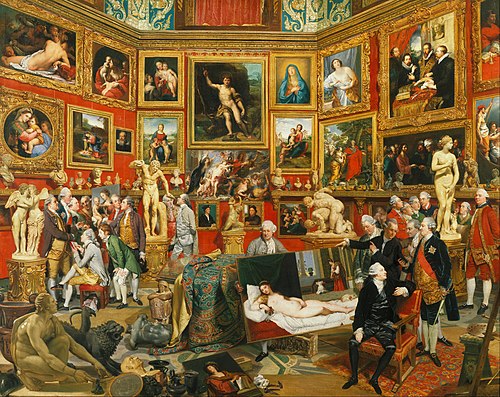
The Royal Academy Exhibition of 1780 was an art exhibition staged in London by the Royal Academy of Arts. Held between 1 May and 3 June 1780 it was the first to take place at the academy's new headquarters at Somerset House. 489 exhibits were on display and the event attracted more than 61,000 visitors. [1]
Contents
Since the 1769 debut all Summer Exhibitions had taken place in a rented room in Pall Mall. The architect William Chambers designed the new purpose-built headquarters. [2] It took place during the American War of Independence and in which the country faced a growing coalition of enemies. The previous year Britain had been threatened with invasion from a Franco-Spanish Armada. A number of the submissions made reference to the ongoing conflict.
Notable amongst the works on display was Johan Zoffany's The Tribuna of the Uffizi , a royal commission from Queen Charlotte which he had travelled to Florence to produce. [3] Benjamin West submitted a large number of works including history paintings recounting victories in the Nine Years War almost a century earlier. He also showed a range of portraits of the royal family including George III, Charlotte and a joint picture of their sons William, Duke of Clarence and Edward, Duke of Kent. His fellow American John Singleton Copley submitted a full-length depiction of the Highland soldier Hugh Montgomerie. [4] His more limited offering thay year was because he was working on his large The Death of the Earl of Chatham . [5]
Joshua Reynolds, the President of the Royal Academy, demonstrated his versatility with a variety of submissions featuring the young Prince William Frederick and the historian Edward Gibbon. He also showed Justice part of his series featuring the four cardinal virtues. [6] He also produced his own portraits of George III and Queen Charlotte to hang on the walls of the new academy. [4] His Portrait of Lady Worsley featured a fashionable aristocratic wearing a costume inspired by the militia uniform of her husband's regiment. [7] Other war-themed paintings were Francis Holman's The Moonlight Battle featuring a British naval victory over the Spanish while sailing to relieve the besieged garrison at Gibraltar. [8] Philip James de Loutherbourg depicted Warley Camp a painting of a military review by George III of troops gathered to resist invasion. [9]
Thomas Gainsborough submitted a number of painters but was disappointed by their placings in the exhibition, a growing issue with the academy which would ultimately lead to his boycotting it. [10] His work on display included six landscapes and several portraits including his friend Henry Bate Dudley and the actor John Henderson. [11] He also presented a portrait of the German musician Johann Christian Fischer, who was briefly his son-in-law. [12]















